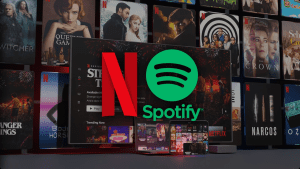Introduction
The internet has changed many things in our lives, including how we get our news and entertainment. Before the internet, people mainly used traditional media like TV, radio, newspapers, and magazines. Today, the internet gives us new ways to access content. This article explains how the internet has impacted traditional media and what this means for the future.
The Shift from Traditional Media to Digital

1. Traditional Media Before the Internet
Before the internet, TV, radio, newspapers, and magazines were the main ways people got their information. You had to wait for the news to come on at certain times. Content was controlled by TV stations, radio channels, and editors in charge of newspapers.
2. How the Internet Changed Everything
When the internet became popular, it changed how people get information. Websites, social media, and streaming services gave people many new ways to find and watch content. The internet is also interactive, meaning anyone can create and share content. It made information and entertainment easier to access and share.
How People Consume Media Has Changed

1. From Passive to Active Consumption
In traditional media, people had no choice but to watch or listen to what was scheduled. TV shows and radio programs aired at set times. With the internet, people can watch, read, or listen to whatever they want at any time. Services like YouTube, Netflix, and Spotify let users pick their content whenever they like.
2. Personalization: Getting What You Want
The internet also allows people to get content that matches their interests. On platforms like Facebook and Instagram, you see posts based on what you like and engage with. In contrast, traditional media showed content meant for a large group, which may not match everyone’s preferences.
3. Decline of Print Media
Newspapers and magazines have faced challenges because of the internet. Many people now get news online because it’s faster and often free. Online sources also include videos and live updates, which print media can’t always offer. As a result, print media is losing readers and advertising money.
How the Internet Has Changed the Media Business

1. Shift in Advertising
In the past, traditional media made money by selling ads. TV stations, radio stations, and newspapers sold ad space during their programs. With the internet, companies like Google and Facebook now show ads based on user data. This makes online advertising more effective. Traditional media is losing advertising money because of this shift.
2. Subscriptions and Paywalls
To make up for lost advertising revenue, some traditional media have started charging for online content. Many newspapers, magazines, and even TV stations now offer subscriptions. But because the internet has so much free content, it’s hard for traditional media to get people to pay for theirs.
3. Fewer Viewers and Readers
Traditional TV shows, radio stations, and newspapers are losing their audience. People prefer to watch shows on streaming platforms like Netflix and Hulu, or get news from websites. The internet offers more flexibility, and traditional media can’t compete with that.
The Role of Social Media in the Changing Media Landscape

1. Social Media’s Rise
Social media platforms, such as Facebook, Twitter, Instagram, and TikTok, are now important sources of news and entertainment. These platforms let anyone share content and have their voices heard. Unlike traditional media, which was controlled by large companies, social media lets everyone create content and connect with others.
2. Social Media and Journalism
Many people now get breaking news on social media, sometimes before it appears on TV or in newspapers. This has forced traditional media to use social media to share updates and connect with their audiences. But social media can spread false information quickly, which is a problem for traditional media in verifying the news.
The Impact of Social Media on Traditional Media
Social media has played a huge role in changing how we consume media. Platforms like Facebook, Twitter, Instagram, and TikTok allow people to share information instantly, which is something traditional media could not do before. News spreads quickly through social media, often faster than on TV or in newspapers. This has forced traditional media to adapt by using social media to share updates and connect with their audience. However, the rise of social media has also led to the spread of misinformation, which traditional media tries to control by verifying facts.
How Streaming Services Are Changing TV and Movies

Streaming services like Netflix, Hulu, and YouTube have drastically changed how we watch TV and movies. Instead of waiting for a show to air at a certain time, we can now watch content whenever we want. Streaming platforms offer a wide variety of shows, movies, and documentaries that traditional TV networks can’t compete with. This has led to a decline in traditional TV viewership, as more people choose streaming services for their entertainment needs. Streaming is flexible and often cheaper than traditional cable subscriptions, which has made it even more popular.
The Growth of Online News Platforms
The internet has made it easier to access news, with many websites and apps offering real-time updates. This has led to a decline in the number of people reading newspapers and watching the evening news. Online news platforms provide content that is often updated throughout the day, unlike traditional media which updates less frequently. Many news websites are free to access, while traditional newspapers have started charging for online content. As a result, more people are turning to digital sources for their news, leaving traditional media struggling to keep up.
The Changing Role of Advertising in Media

Advertising has always been a major source of revenue for traditional media. However, the rise of the internet has made advertising more targeted and personalized. Online platforms like Google and Facebook collect data about users, which allows them to show ads based on individual interests. This is more effective for advertisers, making it harder for traditional media to compete. Many traditional media outlets have started offering online ads and sponsored content to stay relevant, but the shift in advertising is one of the biggest challenges they face.
The Importance of Adaptation for Traditional Media
For traditional media to survive in the internet age, it needs to adapt. Many newspapers, TV stations, and radio channels are already making the shift to online platforms. Offering digital subscriptions, creating apps, and live-streaming events are ways traditional media is trying to stay connected with audiences. The key for traditional media will be finding a balance between embracing new technology while still providing high-quality, reliable content. Those that can successfully adapt to the digital world will continue to thrive, while others may struggle to stay relevant in a rapidly changing media landscape.
How the Internet Has Made Content More Interactive

One of the major changes the internet has brought to media is increased interactivity. On traditional TV or radio, viewers and listeners had no way to directly interact with the content. However, the internet allows people to comment, share, and like content. Social media platforms let people discuss news and entertainment with others in real-time. This change has forced traditional media to rethink how they engage with their audiences. Many newspapers, TV channels, and radio stations now use online platforms to allow people to interact with their content and provide feedback.
Working Together: Internet and Traditional Media
Instead of competing, the internet and traditional media can work together. Many newspapers, TV channels, and radio stations are now using the internet to share their content. They post on social media, create podcasts, and stream live events. By combining the strengths of both worlds, traditional media can stay relevant while giving audiences what they want: fast, flexible, and trustworthy content.
Challenges Faced by Traditional Media
Traditional media faces several challenges due to the rise of the internet. One of the biggest issues is the loss of advertising revenue. Online platforms like Google and Facebook offer targeted ads that are more appealing to advertisers. Traditional media also struggles to compete with the vast amount of free content available online. Another challenge is the decline in traditional readers and viewers, as more people turn to the internet for their news and entertainment, leaving newspapers, TV, and radio behind.
Looking Ahead: The Future of Traditional Media

The future of traditional media is uncertain but filled with potential. For traditional media to stay relevant, it must adapt to the changing landscape by embracing digital platforms and technologies. Many traditional outlets are already offering online content and using social media to stay connected with their audiences. The key to success will be balancing traditional methods with modern digital tools, providing high-quality content while adapting to the growing demand for instant and personalized media.
1. Adapting to Change
To survive in the digital age, traditional media must adapt. Some outlets have started offering content online, live streaming, and engaging with audiences on social media. The future may involve a mix of traditional and digital media, offering better experiences for consumers.
2. New Technologies Shaping Media
Emerging technologies like virtual reality (VR) and artificial intelligence (AI) are also shaping the future of media. VR is being used for more immersive experiences, such as virtual tours. AI can help media outlets recommend content based on user preferences. Traditional media needs to explore these technologies to stay competitive.
3. Innovation is Key
To stay relevant, traditional media must continue to innovate. This could involve creating better user experiences, offering more interactive features, and finding new ways to make money. Traditional media must embrace the internet while still offering high-quality content that people enjoy.
Comparison of Internet and Traditional Media
| Factor | Traditional Media | Internet Media |
|---|---|---|
| Content Access | Fixed times (e.g., TV shows, news) | On-demand, anytime access |
| Audience Control | Limited control over content | Full control over what, when, and how to consume |
| Content Creation | Limited creators (e.g., TV stations) | Anyone can create and share content |
| Advertising Revenue | Ads shown to everyone | Targeted ads based on user data |
| Business Model | Subscription, advertising, pay-per-view | Subscriptions, ads, freemium models |
| Interactivity | Limited interaction (e.g., phone calls) | Active participation (e.g., likes, shares) |
Conclusion
The internet has had a big impact on traditional media. It has changed how we get our news and entertainment and affected how media businesses make money. While traditional media faces challenges, it also has opportunities to adapt and thrive. The future will likely involve a mix of traditional and digital platforms, offering a variety of ways to enjoy content.











